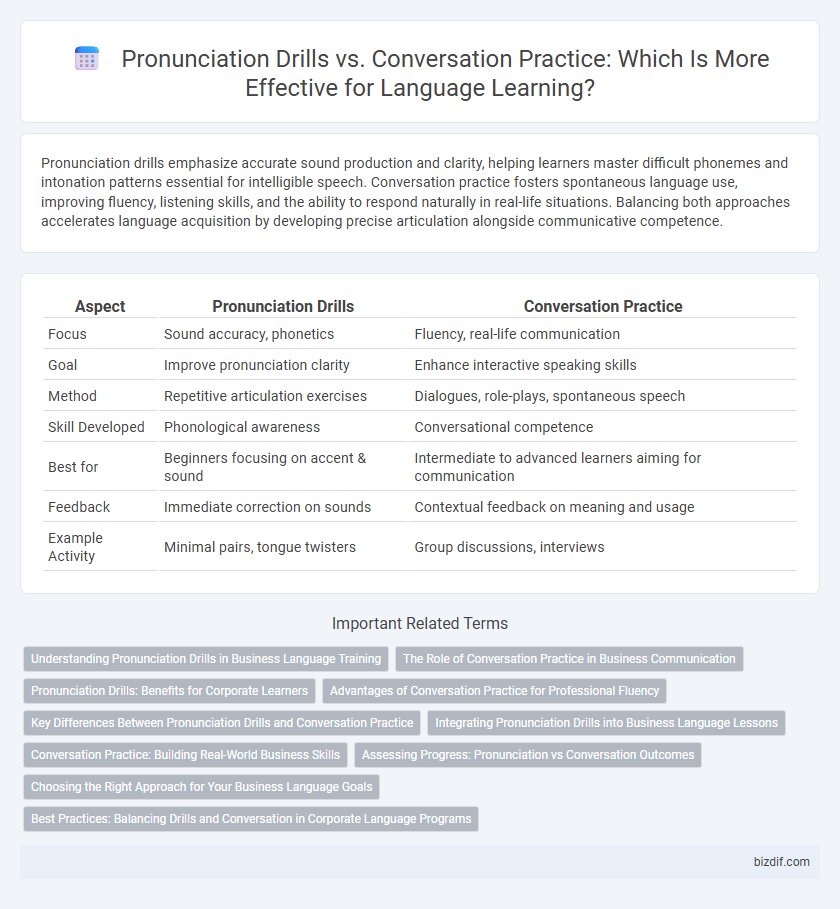Pronunciation drills emphasize accurate sound production and clarity, helping learners master difficult phonemes and intonation patterns essential for intelligible speech. Conversation practice fosters spontaneous language use, improving fluency, listening skills, and the ability to respond naturally in real-life situations. Balancing both approaches accelerates language acquisition by developing precise articulation alongside communicative competence.
Table of Comparison
| Aspect | Pronunciation Drills | Conversation Practice |
|---|---|---|
| Focus | Sound accuracy, phonetics | Fluency, real-life communication |
| Goal | Improve pronunciation clarity | Enhance interactive speaking skills |
| Method | Repetitive articulation exercises | Dialogues, role-plays, spontaneous speech |
| Skill Developed | Phonological awareness | Conversational competence |
| Best for | Beginners focusing on accent & sound | Intermediate to advanced learners aiming for communication |
| Feedback | Immediate correction on sounds | Contextual feedback on meaning and usage |
| Example Activity | Minimal pairs, tongue twisters | Group discussions, interviews |
Understanding Pronunciation Drills in Business Language Training
Pronunciation drills in business language training target precise articulation and stress patterns essential for clear professional communication. These drills enhance phonetic accuracy, reducing misunderstandings in high-stakes corporate interactions. While conversation practice builds fluency, focused pronunciation exercises ensure clarity and confidence in delivering business messages.
The Role of Conversation Practice in Business Communication
Conversation practice plays a crucial role in business communication by enhancing real-time language processing and contextual understanding, which pronunciation drills alone cannot achieve. Engaging in authentic dialogues improves fluency, pragmatics, and the ability to navigate complex social cues essential for professional interactions. Effective business communication depends on mastering interactive speaking skills, making conversation practice indispensable for language learners aiming to succeed in corporate environments.
Pronunciation Drills: Benefits for Corporate Learners
Pronunciation drills enhance corporate learners' clarity and confidence, directly improving professional communication and reducing misunderstandings in global business settings. These targeted exercises develop accurate speech patterns and intonation, essential for presentations, negotiations, and client interactions. Regular pronunciation practice accelerates language acquisition and boosts overall fluency, leading to more effective workplace performance.
Advantages of Conversation Practice for Professional Fluency
Conversation practice enhances professional fluency by fostering real-time language processing and improving spontaneous speaking skills. It provides exposure to diverse vocabulary and idiomatic expressions, essential for effective workplace communication. This interactive approach also builds cultural awareness and confidence, crucial for successful professional interactions.
Key Differences Between Pronunciation Drills and Conversation Practice
Pronunciation drills emphasize repetitive practice of specific sounds and phonetic patterns to improve accuracy and clarity, targeting individual speech components such as intonation, stress, and articulation. Conversation practice centers on spontaneous language use in real-life contexts, enhancing fluency, vocabulary, and interactive communication skills through dynamic dialogue and natural exchanges. The key difference lies in drills developing precise sound production, while conversation practice fosters practical language application and comprehension in social interactions.
Integrating Pronunciation Drills into Business Language Lessons
Integrating pronunciation drills into business language lessons enhances clarity and professional communication by targeting specific phonetic challenges common in corporate settings. Pronunciation drills improve accuracy and fluency, enabling learners to articulate industry-specific terminology confidently. Combining these drills with conversation practice maximizes retention and applies refined speech patterns in realistic business interactions.
Conversation Practice: Building Real-World Business Skills
Conversation practice in language instruction enhances real-world business communication by simulating authentic workplace scenarios, enabling learners to develop fluency, negotiation skills, and cultural awareness. Unlike pronunciation drills that focus on phonetic accuracy, conversation practice fosters interactive dialogue, problem-solving, and adaptability essential for effective business exchanges. Integrating scenario-based role plays, meetings, and presentations in conversation practice directly prepares learners for professional environments where spontaneous communication is critical.
Assessing Progress: Pronunciation vs Conversation Outcomes
Pronunciation drills offer measurable improvements in phonetic accuracy, enabling precise assessment through tools like spectrogram analysis or phoneme recognition software. Conversation practice evaluates communicative competence by assessing fluency, responsiveness, and contextual language use, often measured via real-time interaction scores or conversational rubrics. Combining both methods provides a balanced overview of language proficiency, capturing both technical articulation and pragmatic communication skills.
Choosing the Right Approach for Your Business Language Goals
Pronunciation drills enhance clarity and professionalism by targeting specific phonetic challenges, making them essential for roles requiring precise communication such as client presentations or negotiations. Conversation practice fosters fluency and spontaneous language use, improving confidence and adaptability in everyday business interactions and networking. Selecting the right approach depends on your team's immediate language needs--whether perfecting accent and enunciation or boosting natural conversational skills to achieve effective workplace communication.
Best Practices: Balancing Drills and Conversation in Corporate Language Programs
Effective corporate language programs balance pronunciation drills with conversation practice to enhance both accuracy and fluency. Pronunciation drills reinforce phonetic skills essential for clear communication, while conversation practice builds contextual language use and confidence in real-world scenarios. Integrating structured drills alongside dynamic speaking activities ensures comprehensive language development and improved employee communication performance.
Pronunciation drills vs Conversation practice Infographic

 bizdif.com
bizdif.com